Influence of Parameter Uncertainties in Carbon Footprint Assessments on the Magnitude of Product-Related Ecological Measures
Abstract
:1. Introduction
2. Literature Review
2.1. Ecological Measures to Reduce a Product’s Carbon Footprint
2.2. The State of the Art of Uncertainties in Life Cycle Assessments and the Necessity for User-Friendly Approaches
2.3. Influence of Uncertainties on Ecological Measure Magnitude Targets
3. Materials and Methods
3.1. Influence of CFPA Parameter Uncertainties on the Magnitude of Ecological Measures

3.2. CFPA Calculation Basis
3.3. Estimation of the GHG ERT Required EMMs and the Uncertainty Derived EMM Adjustments
3.4. Visualization Methods
4. Results—Perturbation Analysis
4.1. Influence of a CFPA Parameter Uncertainty on the Required EMM
4.2. Uncertainty-Related Adjustment of Mass Reduction or Recycled Content to Fulfill a GHG ERT
4.2.1. Uncertainties in the Mass-Induced Use Phase Environmental Impact
4.2.2. Uncertainties in the Primary Material Acquisition Environmental Impact
4.2.3. Uncertainties in the Scrap Rate
4.2.4. Uncertainties in the Recycling Material Environmental Impact
4.2.5. Uncertainties in the Manufacturing Process Environmental Impact
4.3. Side-by-Side Comparisons of Necessary Measure Adjustments Due to Single Parameter Uncertainties
5. Discussion—Generic Use Case
6. Conclusions and Outlook
Author Contributions
Funding
Institutional Review Board Statement
Informed Consent Statement
Data Availability Statement
Conflicts of Interest
Abbreviations and Symbols
| Abbreviations | ||
| CFP | Carbon Footprint | |
| CFPA | Carbon Footprint Assessment | |
| EMM | Ecological Measure Magnitude | |
| eq | Equivalent | |
| ERT | Emissions Reduction Target | |
| EU | European Union | |
| GHG | Greenhouse Gas | |
| ICEV | Internal Combustion Engine Vehicle | |
| IPCC | Intergovernmental Panel on Climate Change | |
| LCA | Life Cycle Assessment | |
| Symbols | ||
| -eq | Environmental impact of the manufacturing process | |
| -eq | Environmental impact of the primary material acquisition and semi-finished product provision | |
| -eq | Environmental impact of the recycling process and semi-finished product provision | |
| -eq | Environmental impact of phase 1 of the scope of investigation | |
| -eq | Environmental impact of phase 2 of the scope of investigation | |
| -eq | Environmental impact of phase 3 of the scope of investigation | |
| -eq | Mass-induced environmental impact of the use phase | |
| Mass-induced fuel consumption ICEV | ||
| Vehicle’s mileage | ||
| Environmental impact of the manufacturing process per unit mass | ||
| Environmental impact of the primary material acquisition and semi-finished product provision per unit mass | ||
| Environmental impact of the recycling process and semi-finished product provision per unit mass | ||
| Environmental impact per unit mass of phase 1 of the scope of investigation | ||
| Environmental impact per unit mass of phase 2 of the scope of investigation | ||
| Environmental impact per unit mass of phase 3 of the scope of investigation | ||
| Mass-induced environmental impact of the use phase per unit mass | ||
| Fuel emission factor | ||
| Mass of the needed input material (input mass) | ||
| Mass of the component (output mass) | ||
| % | Mass reduction percentage | |
| % | Recycled material share | |
| % | Scrap rate | |
| Density fuel | ||
| Development process timestamp | ||
| Percentual carbon footprint reduction | ||
Appendix A
Appendix A.1. Diagrams—Uncertainties in the Recycling Process Environmental Impact
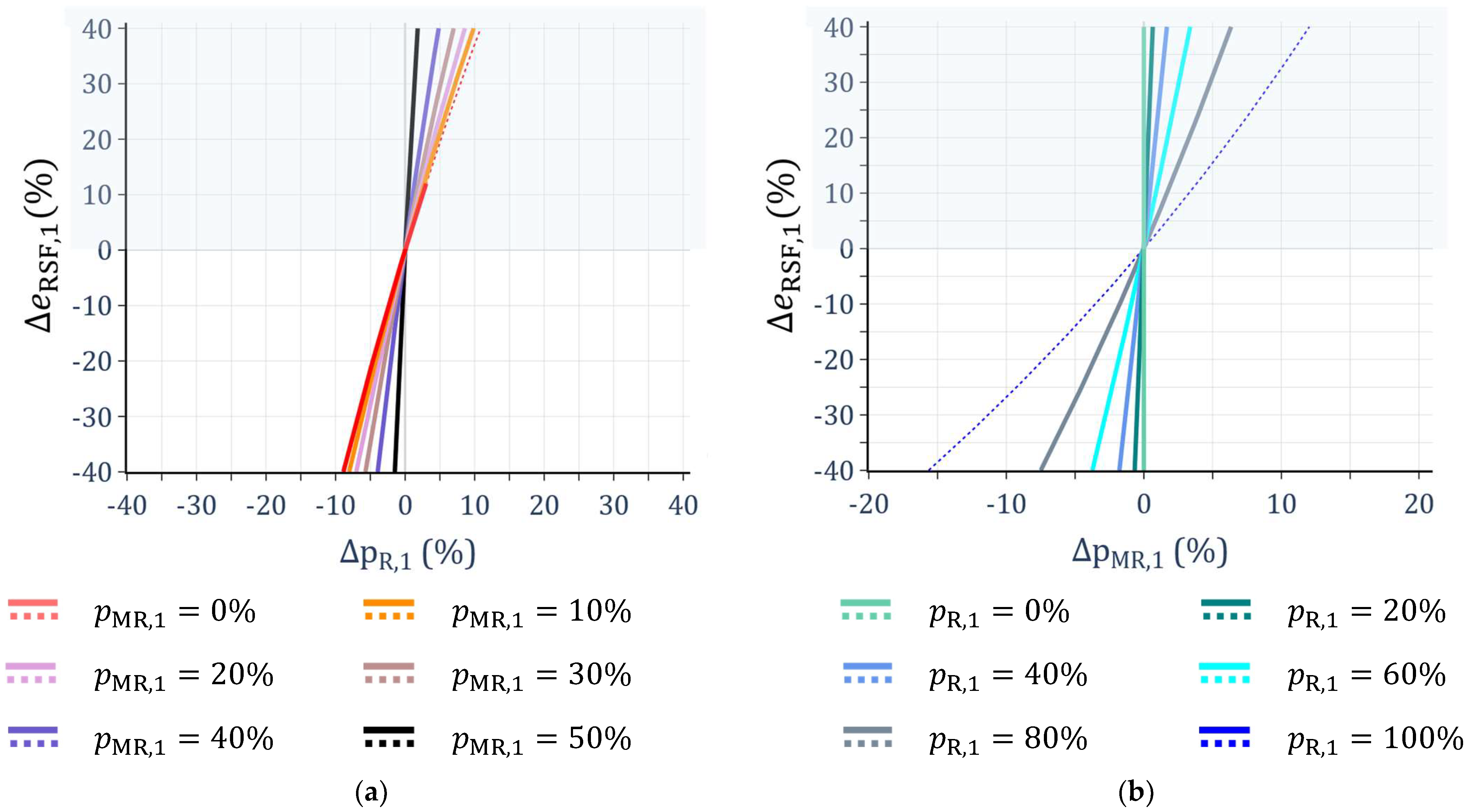
Appendix A.2. Diagrams—Uncertainties in the Manufacturing Process Environmental Impact
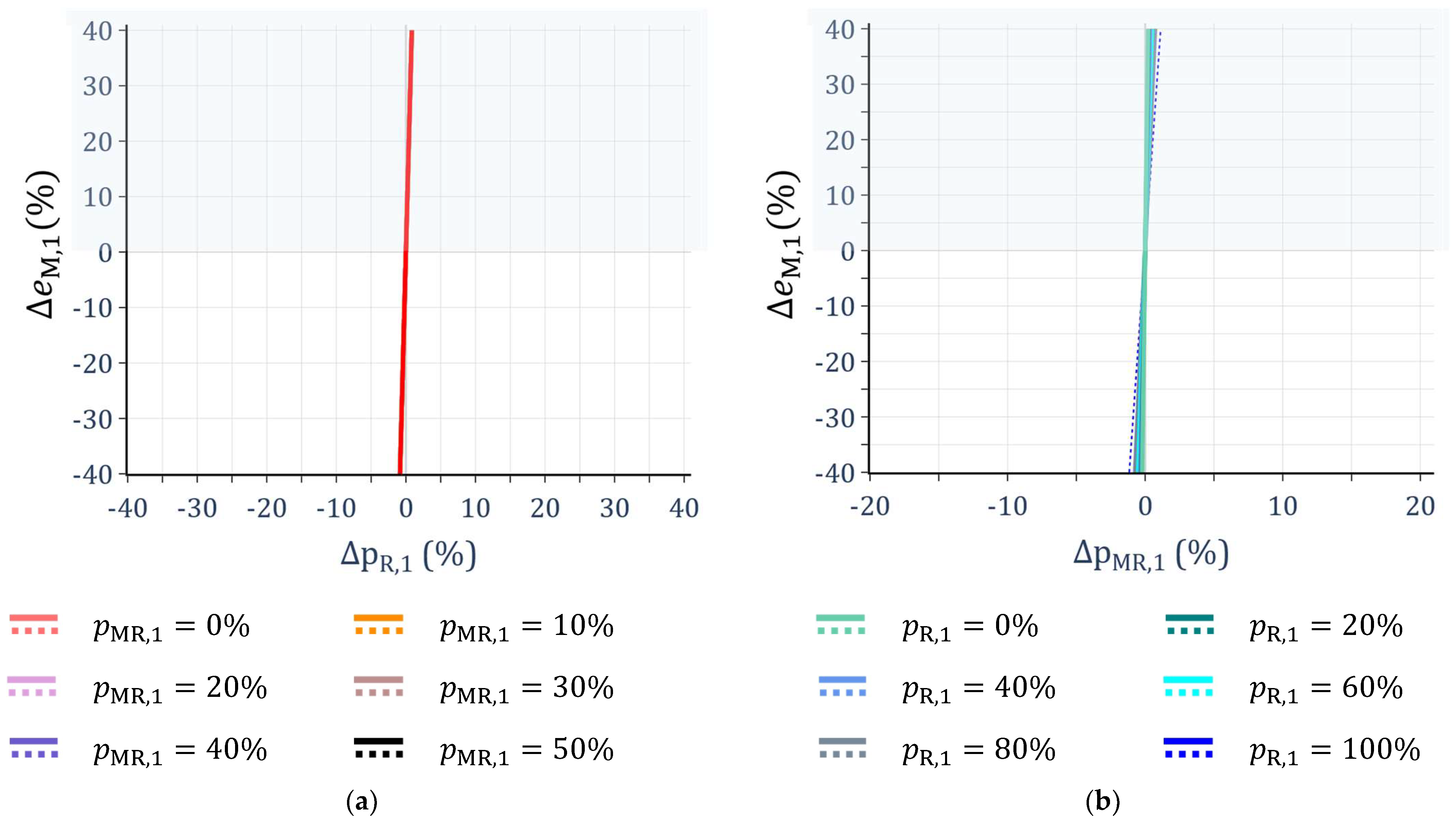
Appendix A.3. Use Case 2: Increased Energy Demand of the Recycling Process
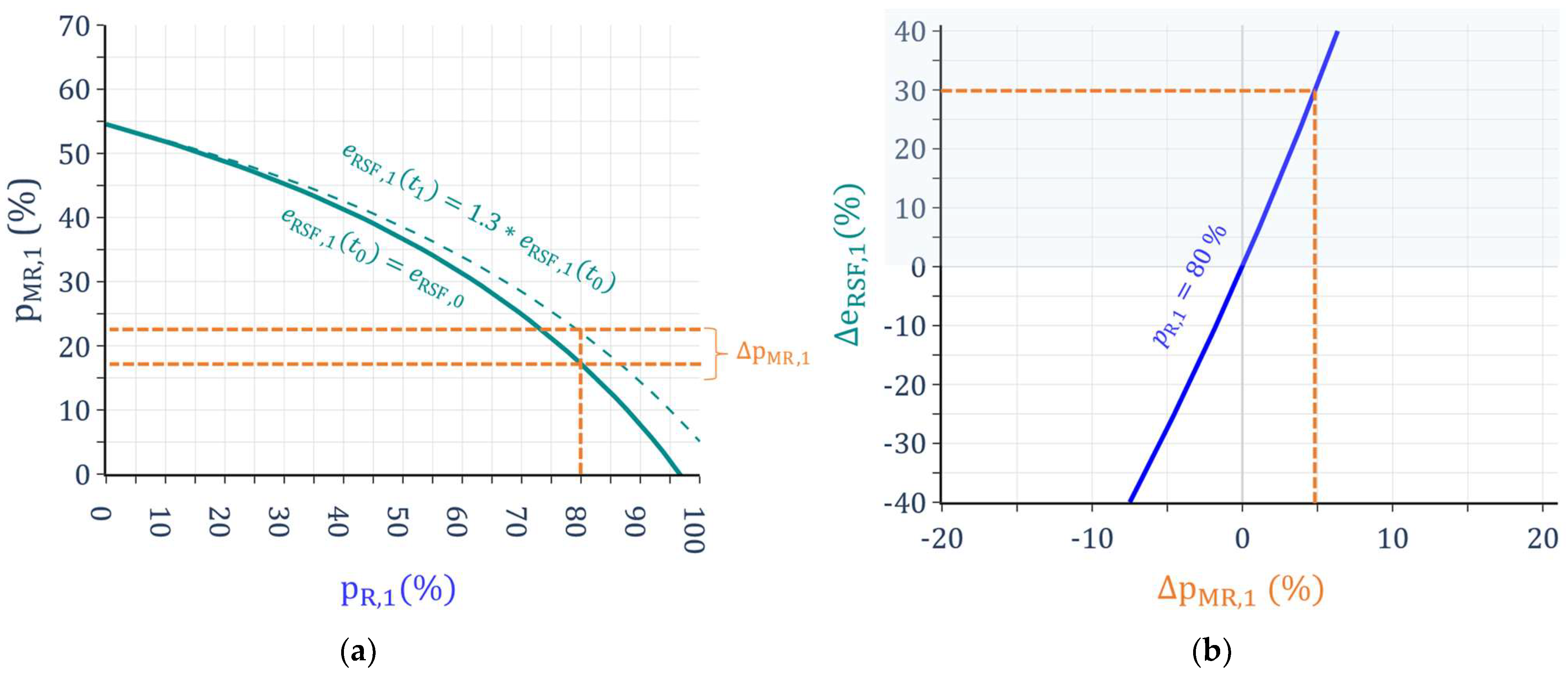
References
- United Nations. Paris Agreement. Available online: https://unfccc.int/sites/default/files/english_paris_agreement.pdf (accessed on 8 July 2024).
- European Commission. Communication from the Commission: The European Green Deal. COM/2019/640 Final. Available online: https://eur-lex.europa.eu/legal-content/EN/TXT/?uri=CELEX:52019DC0640 (accessed on 30 June 2024).
- European Commission. Communication from the Commission to the European Parliament, the Council, the European Economic and Social Committee and the Committee of the Regions: Sustainable and Smart Mobility Strategy—Putting European Transport on Track for the Future. COM/2020/789 Final. Available online: https://eur-lex.europa.eu/legal-content/EN/TXT/?uri=CELEX%3A52020DC0789 (accessed on 7 July 2024).
- Kuhnert, F.; Bockwinkel, A.; MacRae, C.J.; Johansson, C. The Automotive Industry and Climate Change. Available online: https://www.pwc.com/th/en/automotive/assets/co2.pdf (accessed on 8 July 2024).
- Morgadinho, L.; Oliveira, C.; Martinho, A. A qualitative study about perceptions of European automotive sector’s contribution to lower greenhouse gas emissions. J. Clean. Prod. 2015, 106, 644–653. [Google Scholar] [CrossRef]
- Hetterich, J.; Bonnemeier, S.; Georgiadis, A. Ecological sustainability—A customer requirement? Evidence from the automotive industry. J. Environ. Plan. Manag. 2012, 55, 1111–1133. [Google Scholar] [CrossRef]
- Poligkeit, J.; Fugger, T.; Herrmann, C. Decarbonization in the Automotive Sector: A Holistic Status Quo Analysis of Original Equipment Manufacturer Strategies and Carbon Management Activities. Sustainability 2023, 15, 15753. [Google Scholar] [CrossRef]
- Hannon, E.; Nauclér, T.; Suneson, A.; Yüksel, F. The Zero-Carbon Car: Abating Material Emissions Is Next on the Agenda. Available online: https://www.mckinsey.com/business-functions/sustainability/our-insights/the-zero-carbon-car-abating-material-emissions-is-next-on-the-agenda (accessed on 8 July 2024).
- EN ISO 14067:2018; Greenhouse Gases—Carbon Footprint of Products—Requirements and Guidelines for Quantification (ISO 14067:2018). Beuth Verlag GmbH: Berlin, Germany, 2018.
- Reitmeier, J.; Luft, T.; Paetzold, K.; Wartzack, S. Consideration of Uncertainties in the Product Development Process. In Modelling and Management of Engineering Processes; Schabacker, M., Gericke, K., Szélig, N., Vajna, S., Eds.; Springer: Berlin/Heidelberg, Germany, 2015; pp. 137–149. ISBN 978-3-662-44009-4. [Google Scholar]
- Herstatt, C.; Verworn, B. The ‘Fuzzy Front End’ of Innovation. In Bringing Technology and Innovation into the Boardroom: Strategy, Innovation and Competences for Business Value; European Institute for Technology and Innovation Management, Ed.; Palgrave Macmillan: Basingstoke, UK, 2004; pp. 347–372. ISBN 978-0-230-51277-1. [Google Scholar]
- Kellner, P. Zur systematischen Bewertung integrativer Leichtbau-Strukturkonzepte für biegebelastete Crashträger, 1st ed.; Cuvillier Verlag: Göttingen, Germany, 2014; ISBN 9783954045525. [Google Scholar]
- Dispinar, D.; Kvithyld, A.; Nordmark, A. Quality Assesment of Recycled Aluminium. In Light Metals 2011; Lindsay, S.J., Ed.; Springer International Publishing: Cham, Switzerland, 2016; pp. 731–735. ISBN 978-3-319-48160-9. [Google Scholar]
- Reuter, M.A.; van Schaik, A.; Ignatenko, O.; de Haan, G.J. Fundamental limits for the recycling of end-of-life vehicles. Miner. Eng. 2006, 19, 433–449. [Google Scholar] [CrossRef]
- DIN EN ISO 14021:2021-10; Environmental Labels and Declarations—Self-Declared Environmental Claims (Type II Environmental Labelling) (ISO 14021:2016 + Amd 1:2021); German Version EN ISO 14021:2016 + A1:2021. Beuth Verlag GmbH: Berlin, Germany, 2021.
- Lee, J.C.; Edil, T.B.; Tinjum, J.M.; Benson, C.H. Quantitative Assessment of Environmental and Economic Benefits of Recycled Materials in Highway Construction. Transp. Res. Rec. 2010, 2158, 138–142. [Google Scholar] [CrossRef]
- Kong, M.; Ji, C.; Hong, T.; Kang, H. Impact of the use of recycled materials on the energy conservation and energy transition of buildings using life cycle assessment: A case study in South Korea. Renew. Sustain. Energy Rev. 2022, 155, 111891. [Google Scholar] [CrossRef]
- Folkson, R. (Ed.) Alternative Fuels and Advanced Vehicle Technologies for Improved Environmental Performance; Woodhead Publishing: Sawston, UK, 2014; ISBN 978-0-85709-522-0. [Google Scholar]
- Palinkas, I.; Pekez, J.; Novakovic, B.; Djurdjev, M. Mass Reduction Methods for Energy Efficiency Improvement of Vehicles. In 30th International Conference on Organization and Technology of Maintenance (OTO 2021); Glavaš, H., Hadzima-Nyarko, M., Karakašić, M., Ademović, N., Avdaković, S., Eds.; Springer International Publishing: Cham, Switzerland, 2022; pp. 71–80. ISBN 978-3-030-92851-3. [Google Scholar]
- Warsen, J.; Krinke, S. The life cycle approach at Volkswagen. ATZ Worldw. 2012, 114, 4–9. [Google Scholar] [CrossRef]
- Zhang, W.; Xu, J. Advanced lightweight materials for Automobiles: A review. Mater. Des. 2022, 221, 110994. [Google Scholar] [CrossRef]
- Gonçalves, M.; Monteiro, H.; Iten, M. Life Cycle Assessment studies on lightweight materials for automotive applications—An overview. Energy Rep. 2022, 8, 338–345. [Google Scholar] [CrossRef]
- Monteiro, H.; Alonso, R.; Gonçalves, M.; Iten, M.; Caetano, N.S. Life cycle energy of vehicles on lightweighting and alternative powertrain strategies—A review. Energy Rep. 2022, 8, 241–247. [Google Scholar] [CrossRef]
- Mayyas, A.T.; Mayyas, A.R.; Omar, M. 11—Sustainable lightweight vehicle design: A case study in eco-material selection for body-in-white. In Lightweight Composite Structures in Transport; Njuguna, J., Ed.; Woodhead Publishing: Sawston, UK, 2016; pp. 267–302. ISBN 978-1-78242-325-6. [Google Scholar]
- Gallimore, A.; Cheung, W. Effects of Environmental Impact Based on Alternative Materials and Process Selection in Automotive Components Design. J. Ind. Prod. Eng. 2016, 33, 321–338. [Google Scholar] [CrossRef]
- Abdul-Manan, A.F.N. Uncertainty and differences in GHG emissions between electric and conventional gasoline vehicles with implications for transport policy making. Energy Policy 2015, 87, 1–7. [Google Scholar] [CrossRef]
- Reimer, L.; Kaluza, A.; Cerdas, F.; Meschke, J.; Vietor, T.; Herrmann, C. Design of Eco-Efficient Body Parts for Electric Vehicles Considering Life Cycle Environmental Information. Sustainability 2020, 12, 5838. [Google Scholar] [CrossRef]
- Del Pero, F.; Delogu, M.; Kerschbaum, M. Design of a Lightweight Rear Crash Management System in a Sustainable Perspective. Sustainability 2020, 12, 5243. [Google Scholar] [CrossRef]
- Delogu, M.; Del Pero, F.; Pierini, M. Lightweight Design Solutions in the Automotive Field: Environmental Modelling Based on Fuel Reduction Value Applied to Diesel Turbocharged Vehicles. Sustainability 2016, 8, 1167. [Google Scholar] [CrossRef]
- Stegmiller, M.; Albers, A.; Bursac, N. Methods and processes for robust weight management in the automotive industry. In 18. Internationales Stuttgarter Symposium; Bargende, M., Reuss, H.-C., Wiedemann, J., Eds.; Springer Fachmedien Wiesbaden: Wiesbaden, Germany, 2018; pp. 919–934. ISBN 978-3-658-21194-3. [Google Scholar]
- Directorate-General for Environment. Proposal for a Regulation on Circularity Requirements for Vehicle Design and on Management of End-of-Life Vehicles. Available online: https://environment.ec.europa.eu/publications/proposal-regulation-circularity-requirements-vehicle-design-and-management-end-life-vehicles_en (accessed on 8 July 2024).
- Heijungs, R.; Kleijn, R. Numerical approaches towards life cycle interpretation five examples. Int. J. Life Cycle Assess. 2001, 6, 141–148. [Google Scholar] [CrossRef]
- Heijungs, R.; Huijbregts, M. A Review of Approaches to Treat Uncertainty in LCA. In Proceedings of the 2nd International Congress on Environmental Modelling and Software, Osnabrück, Germany, 14–17 June 2004. [Google Scholar]
- Huijbregts, M.A.J. Application of uncertainty and variability in LCA. Int. J. Life Cycle Assess. 1998, 3, 273–280. [Google Scholar] [CrossRef]
- Igos, E.; Benetto, E.; Meyer, R.; Baustert, P.; Othoniel, B. How to treat uncertainties in life cycle assessment studies? Int. J. Life Cycle Assess. 2019, 24, 794–807. [Google Scholar] [CrossRef]
- Weyand, A.; Bausch, P.; Engel, B.; Metternich, J.; Weigold, M. Analysis of Uncertainty Factors in Part-Specific Greenhouse Gas Accounting. Sustainability 2023, 15, 16871. [Google Scholar] [CrossRef]
- Ross, S.; Evans, D.; Webber, M. How LCA studies deal with uncertainty. Int. J. Life Cycle Assess. 2002, 7, 47–52. [Google Scholar] [CrossRef]
- Björklund, A. Survey of approaches to improve reliability in LCA. Int. J. Life Cycle Assess. 2002, 7, 64–72. [Google Scholar] [CrossRef]
- Guo, M.; Murphy, R.J. LCA data quality: Sensitivity and uncertainty analysis. Sci. Total Environ. 2012, 435–436, 230–243. [Google Scholar] [CrossRef] [PubMed]
- Thonemann, N.; Schulte, A.; Maga, D. How to Conduct Prospective Life Cycle Assessment for Emerging Technologies? A Systematic Review and Methodological Guidance. Sustainability 2020, 12, 1192. [Google Scholar] [CrossRef]
- Bamber, N.; Turner, I.; Arulnathan, V.; Li, Y.; Zargar Ershadi, S.; Smart, A.; Pelletier, N. Comparing sources and analysis of uncertainty in consequential and attributional life cycle assessment: Review of current practice and recommendations. Int. J. Life Cycle Assess. 2020, 25, 168–180. [Google Scholar] [CrossRef]
- Mahmood, A.; Varabuntoonvit, V.; Mungkalasiri, J.; Silalertruksa, T.; Gheewala, S.H. A Tier-Wise Method for Evaluating Uncertainty in Life Cycle Assessment. Sustainability 2022, 14, 13400. [Google Scholar] [CrossRef]
- DIN EN ISO 14040:2021-02; Environmental Management—Life Cycle Assessment—Principles and Framework (ISO 14040:2006 + Amd 1:2020); German version EN ISO 14040:2006 + A1:2020. Beuth Verlag GmbH: Berlin, Germany, 2021.
- DIN EN ISO 14044:2021-02; Environmental Management—Life Cycle Assessment—Requirements and Guidelines (ISO 14044:2006 + Amd 1:2017 + Amd 2:2020); German version EN ISO 14044:2006 + A1:2018 + A2:2020. Beuth Verlag GmbH: Berlin, Germany, 2021.
- Bhatia, P.; Cummis, C.; Brown, A.; Draucker, L.; Rich, D.; Lahd, H. Product Life Cycle Accounting and Reporting Standard: Greenhouse Gas Protocol. Available online: https://ghgprotocol.org/sites/default/files/standards/Product-Life-Cycle-Accounting-Reporting-Standard_041613.pdf (accessed on 8 July 2024).
- Kaebemick, H.; Sun, M.; Kara, S. Simplified Lifecycle Assessment for the Early Design Stages of Industrial Products. CIRP Ann. 2003, 52, 25–28. [Google Scholar] [CrossRef]
- Koffler, C.; Rohde-Brandenburger, K. On the calculation of fuel savings through lightweight design in automotive life cycle assessments. Int. J. Life Cycle Assess. 2010, 15, 128–135. [Google Scholar] [CrossRef]
- Kim, H.C.; Wallington, T.J. Life Cycle Assessment of Vehicle Lightweighting: A Physics-Based Model To Estimate Use-Phase Fuel Consumption of Electrified Vehicles. Environ. Sci. Technol. 2016, 50, 11226–11233. [Google Scholar] [CrossRef]
- Del Pero, F. Tool for the Environmental Assessment in the Automotive Context: Analysis of the Use Stage for Different Typologies of LCA Study. Ph.D. Thesis, Università Degli Studi Firenze, Florence, Italy, 2016. [Google Scholar]
- Messagie, M.; Boureima, F.; Matheys, J.; Sergeant, N.; Timmermans, J.-M.; Macharis, C.; van Mierlo, J. Environmental performance of a battery electric vehicle: A descriptive Life Cycle Assessment approach. World Electr. Veh. J. 2011, 4, 782–786. [Google Scholar] [CrossRef]
- Nemry, F.; Leduc, G.; Mongelli, I.; Uihlein, A. Environmental Improvement of Passenger Cars (IMPRO-Car); Joint Research Center, European Commission: Brussels, Belgium, 2008; ISBN 978-92-79-07694-7. [Google Scholar]
- Eberle, R.; Franze, H. Modelling the Use Phase of Passenger Cars in LCI; SAE Technical Paper 982179; SAE International: Warrendale, PA, USA, 1998. [Google Scholar]
- Ridge, L. EUCAR—Automotive LCA Guidelines—Phase 2; SAE Technical Paper 982185; SAE International: Warrendale, PA, USA, 1998. [Google Scholar]
- Ashby, M.F. (Ed.) Materials and the Environment, 2nd ed.; Butterworth-Heinemann: Boston, MA, USA, 2013; ISBN 978-0-12-385971-6. [Google Scholar]
- European Aluminium. Environmental Profile Report: Life-Cycle Inventory Data for Aluminium Production and Transformation Processes in Europe. Available online: https://european-aluminium.eu/wp-content/uploads/2022/10/european-aluminium-environmental-profile-report-2018-executive-summary.pdf (accessed on 19 March 2023).
- Subic, A.; Schiavone, F. Design-oriented application of LCA to an automotive system. In Proceedings of the 5th Australian Life Cycle Assessment Conference, Melbourne, Australia, 22–24 November 2006. [Google Scholar]
- Juhrich, K. CO2 Emission Factors for Fossil Fuels. Available online: https://www.umweltbundesamt.de/sites/default/files/medien/1968/publikationen/co2_emission_factors_for_fossil_fuels_correction.pdf (accessed on 6 March 2024).

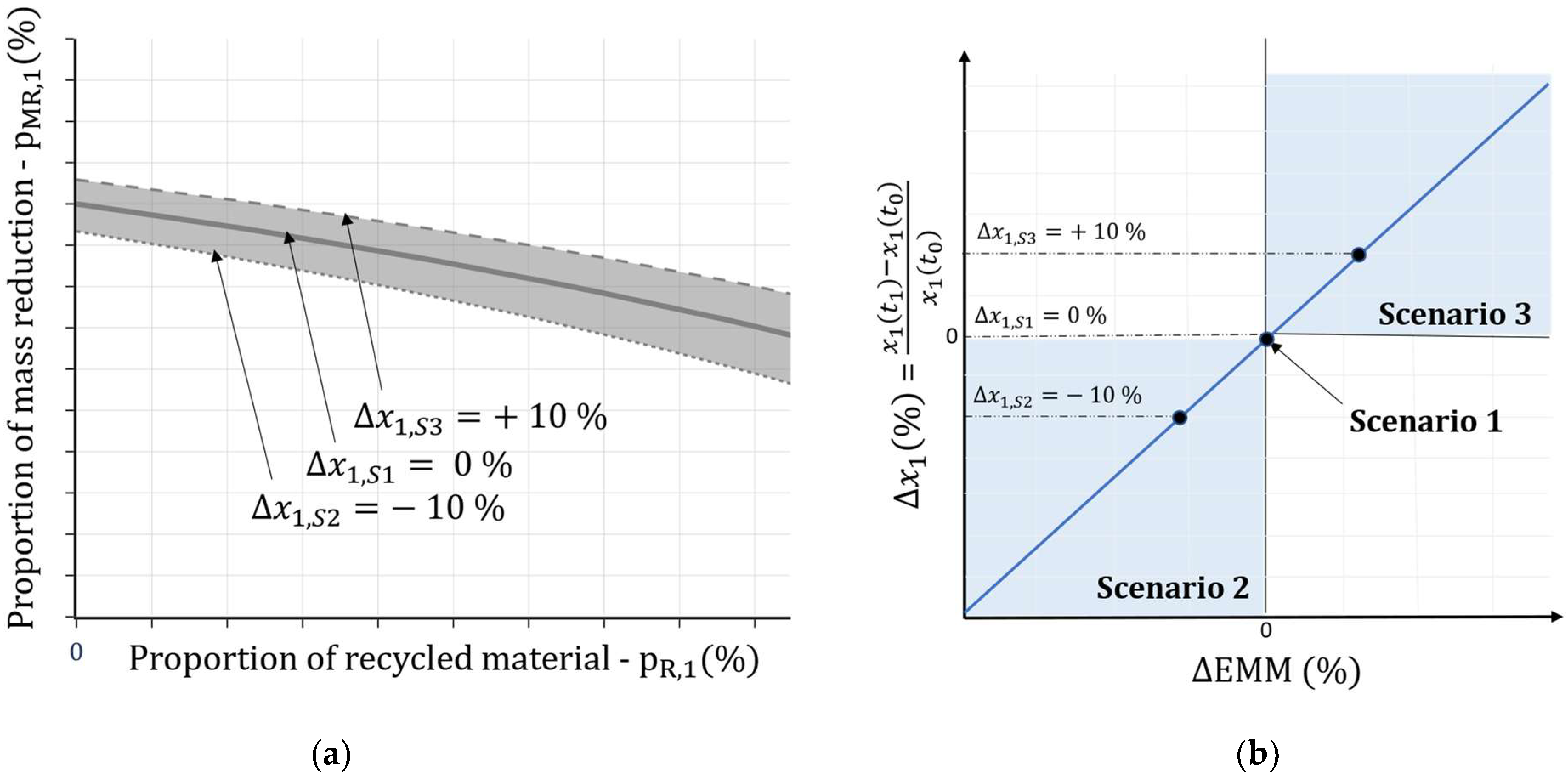

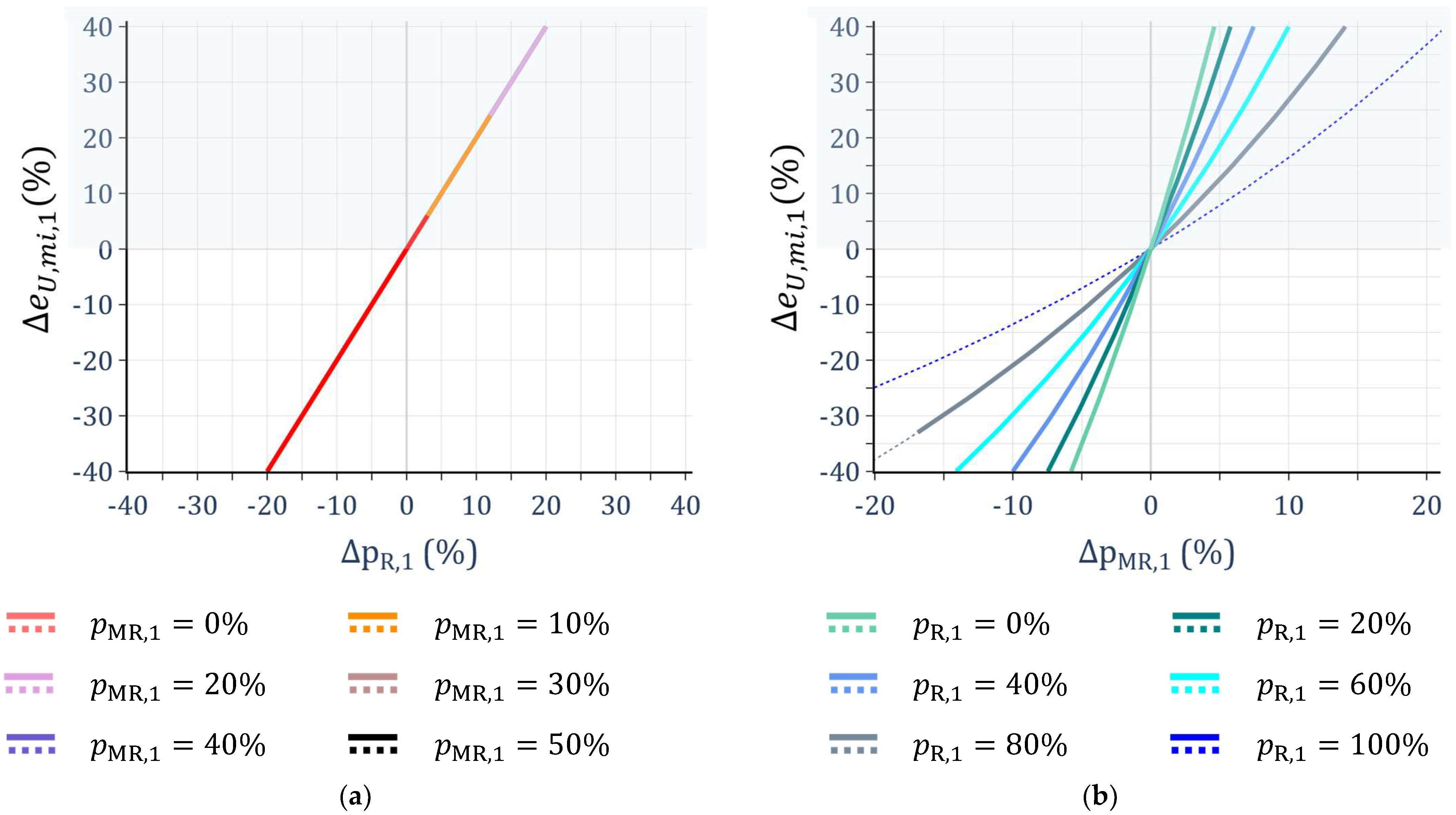


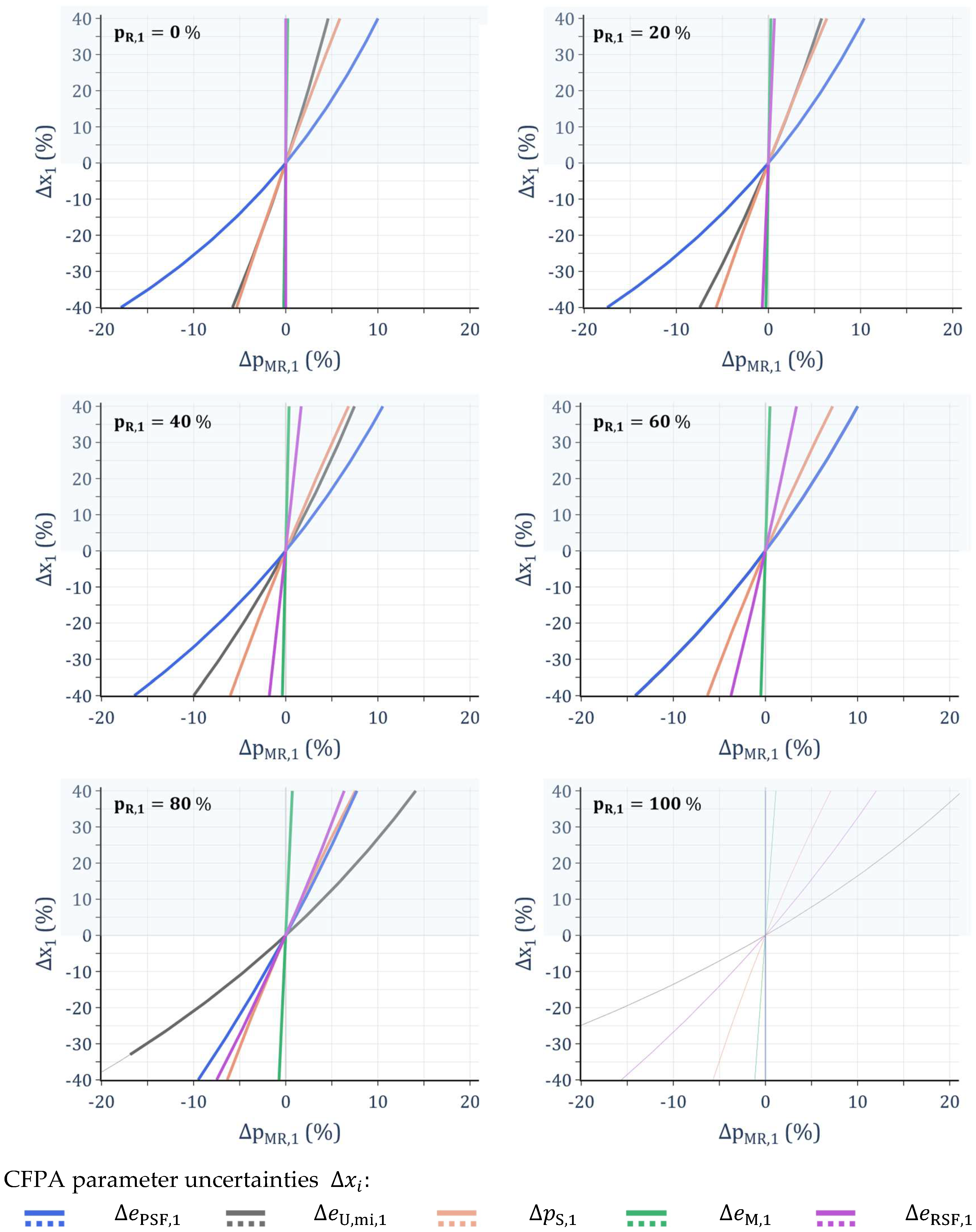
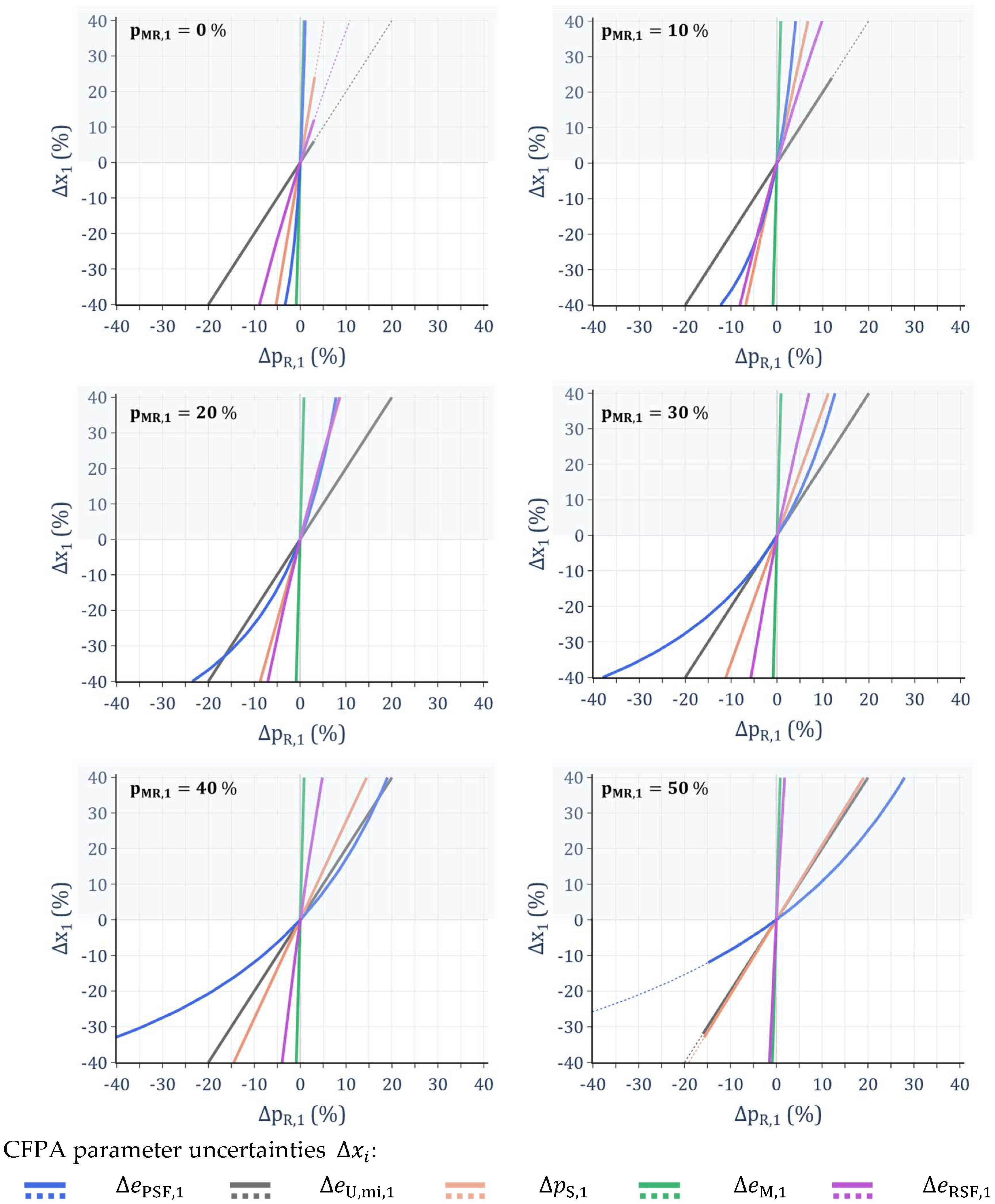
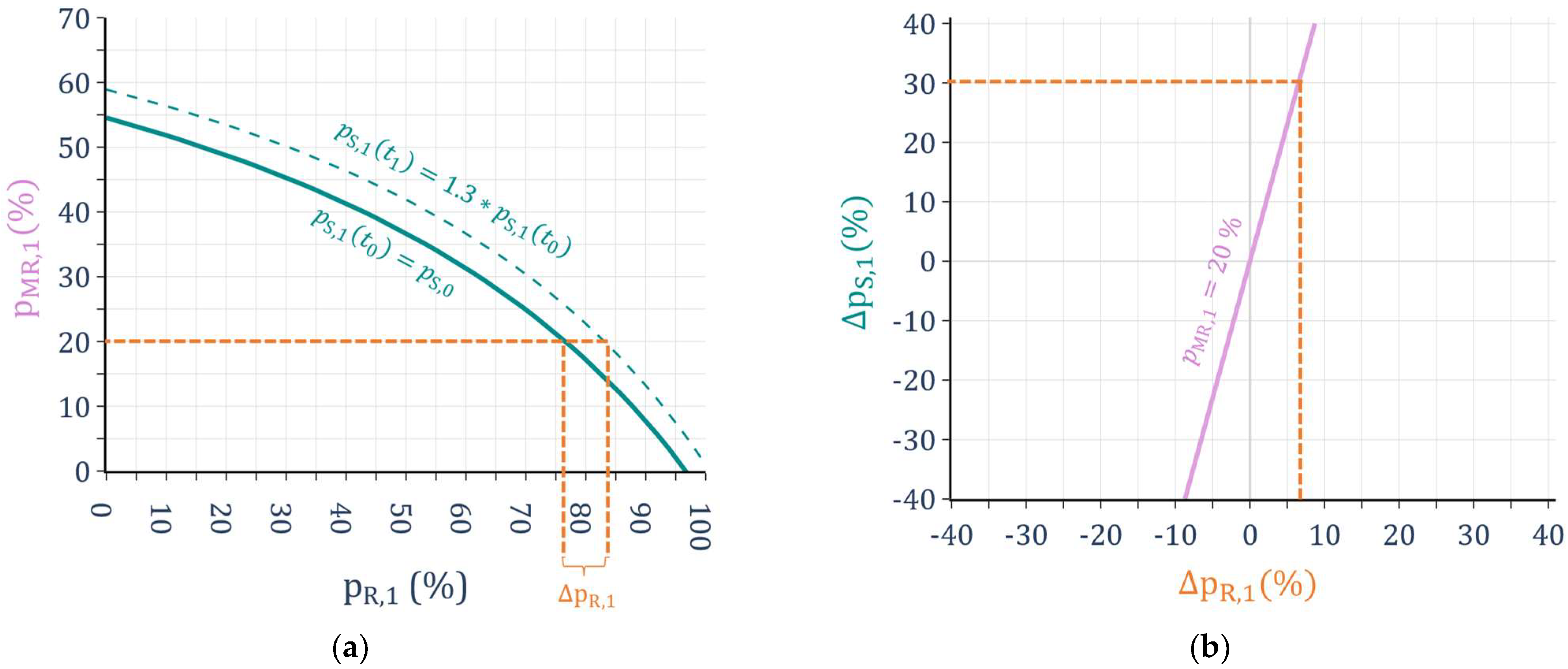
| Timestamp Development Process of Next-Generation Component | Output Parameters | Input Parameters | |
|---|---|---|---|
| Reference Component () | Next-Generation Component () | ||
| , | , , , , | , , , | |
| , | , , , , | , , , | |
| Equation Symbol | Explanation | Value and Unit | Reference |
|---|---|---|---|
| Environmental impact of the primary material acquisition | Al primary material: - | [54] | |
| Environmental impact of the semi-finished product provision | Al sheet production: | [55] | |
| Environmental impact of the primary material and semi-finished product provision | Calculated with Equation (2) | ||
| Environmental impact of the material recycling process | Al recycling process: | [54] | |
| Environmental impact of the material recycling process and semi-finished product provision | Calculated with Equation (3) | ||
| Environmental impact of the manufacturing process | Al deformation processing: - | [54] | |
| Mass-induced fuel consumption ICEV (note: under the assumption of no secondary effects) | [47,53] | ||
| Vehicle lifetime mileage | [53,56] | ||
| Emission factor Super Plus gasoline | [57] | ||
| Density gasoline | [47] | ||
| Mass-induced environmental impact in the use phase | Calculated with Equation (5) | ||
| Scrap rate | 30% | arbitrary | |
| Recycled material share of the reference component | Al: | [54] |
Disclaimer/Publisher’s Note: The statements, opinions and data contained in all publications are solely those of the individual author(s) and contributor(s) and not of MDPI and/or the editor(s). MDPI and/or the editor(s) disclaim responsibility for any injury to people or property resulting from any ideas, methods, instructions or products referred to in the content. |
© 2024 by the authors. Licensee MDPI, Basel, Switzerland. This article is an open access article distributed under the terms and conditions of the Creative Commons Attribution (CC BY) license (https://creativecommons.org/licenses/by/4.0/).
Share and Cite
Rommelfanger, S.; Kilchert, S.; Hiermaier, S. Influence of Parameter Uncertainties in Carbon Footprint Assessments on the Magnitude of Product-Related Ecological Measures. Sustainability 2024, 16, 6373. https://doi.org/10.3390/su16156373
Rommelfanger S, Kilchert S, Hiermaier S. Influence of Parameter Uncertainties in Carbon Footprint Assessments on the Magnitude of Product-Related Ecological Measures. Sustainability. 2024; 16(15):6373. https://doi.org/10.3390/su16156373
Chicago/Turabian StyleRommelfanger, Scally, Sebastian Kilchert, and Stefan Hiermaier. 2024. "Influence of Parameter Uncertainties in Carbon Footprint Assessments on the Magnitude of Product-Related Ecological Measures" Sustainability 16, no. 15: 6373. https://doi.org/10.3390/su16156373





